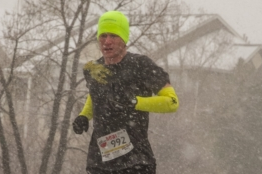During my formative running years a friend of mine said that in a race, the only person who has any business checking behind them is the one in first place. Everyone else should be focusing on the next runner ahead. Besides the symbolic value of focusing on gaining time and catching people ahead of you, there are multiple reasons for this.
Turning your head and looking over your shoulder can slow you down just a fraction of a second. This may not be a big deal in a longer race but to look back repeatedly will add time. (Even the person in first place should minimize their checking.)
If someone turns and checks over their shoulder it can mean two things. It’s possible they feel fine and want to see whether they need to kick it up a gear or keep cruising. Or, they’re running out of gas and are concerned that they’ll get caught. If I look back, I figure I’m giving away information that I don’t want to reveal. While anyone behind me will be trying to catch me anyway, why give them extra motivation?
For these reasons, I almost always keep my eyes looking forward but there are scenarios where I may need to see who’s behind me. A few years ago, I was running a 10K and it was ridiculously hot outside. I’d run the opening half of the race way too fast and with a mile to go, I was in fourth place but struggling. It was obvious that I was not going to catch the person ahead of me so in the interest of maintaining my place, I checked over my shoulder several times in the last mile to see where the next runner was. I gauged what I needed to do to stay ahead of the next folks without falling apart, hoping that I had the energy to do so. I did, and in this situation breaking the rule was, in my mind, justified.
While looking ahead is better, if there are times I need to know who’s behind me there are a few simple ways to do this without actually fully checking over my shoulder.
If the course has turns, especially ones that swing you more than 90 degrees in one direction, once I’m on that turn, I’ll swivel my head just a bit to see who’s behind me. If it’s a 180 degree turn, I won’t even need to turn my head.
If the course goes underneath any roads and thus puts me in a small tunnel, if someone is close behind me, I’ll be able to hear them clearly with the echoes, assuming they enter the tunnel while I’m in there. If I don’t hear anything, I at least have a gap of the tunnel length on them.
Spectators along the course will often give a few claps or small cheers for any runners who come by. If I pass a group of spectators, I listen for when they’re making noise for the next runner and I then know where that person is.
As runners, we want to focus on going faster and, if we’re not in first place, then getting as close to that person as possible. While checking behind you is a natural temptation, minimizing it conserves time, doesn’t reveal how you might be feeling, and keeps you in a better position to improve your time and place.

Running anecdotes, running food reviews, some race coverage, and more